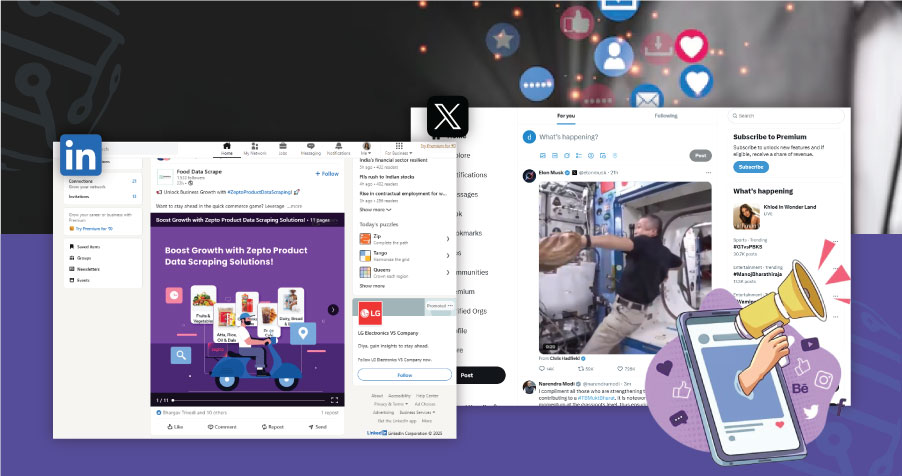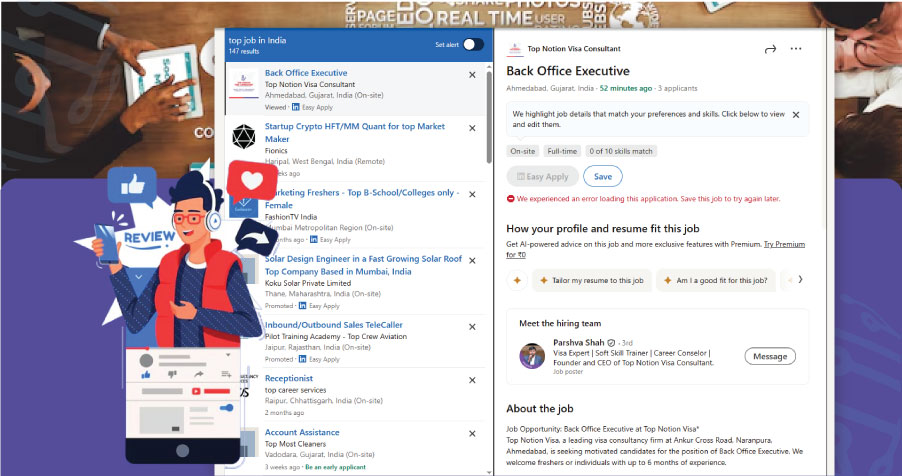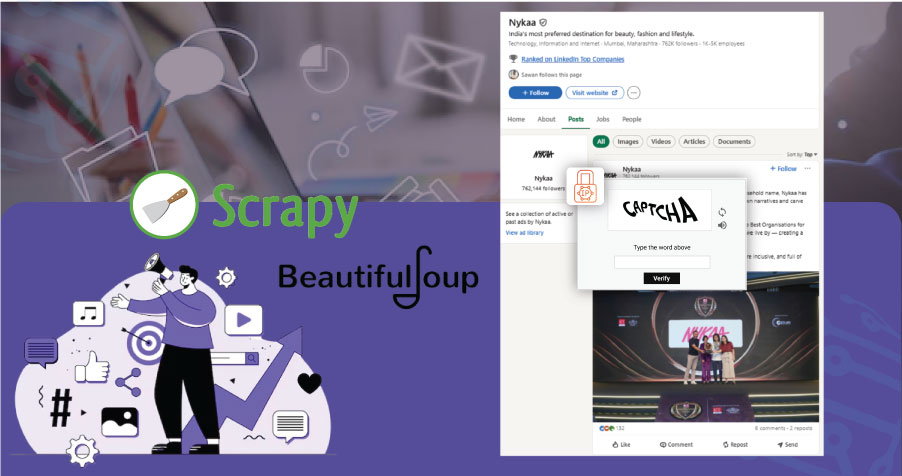-&-LinkedIn-Data-Using-Social-Media-Datasets.jpg)
Introduction
In the digital era, social media datasets have become a goldmine for businesses, marketers, and researchers. Platforms like Twitter (X) and LinkedIn generate vast amounts of user-generated content, offering real-time insights into market trends, consumer preferences, and competitor strategies. Unlike traditional data sources, social media provides a direct view of public sentiment, discussions, and emerging trends, making it a crucial component of any data-driven strategy.
For businesses, social media data scraping allows them to analyze audience behavior, measure brand reputation, and track the effectiveness of marketing campaigns. Extracting Twitter (X) marketing data enables brands to monitor trending hashtags, customer feedback, and influencer impact, while scraping LinkedIn data for marketing insights helps companies identify potential clients, talent acquisition trends, and industry shifts.
By utilizing Twitter (X) social media datasets for marketing, businesses can make informed decisions to enhance their digital strategies. From customer sentiment analysis to competitive benchmarking, the insights derived from LinkedIn marketing analytics datasets and web scraping Twitter (X) sentiment analysis for marketing can significantly improve engagement and ROI.
However, manual data extraction poses significant challenges, making automated solutions such as APIs and web scraping tools essential for efficient and accurate data collection. The next sections will explore how businesses leverage Twitter (X) and LinkedIn data, the obstacles in manual extraction, and the benefits of automation.
Brief Overview of the Importance of Social Media Data

Social media platforms have evolved into critical data sources for businesses, researchers, and marketers. Twitter (X) and LinkedIn alone host millions of daily interactions, providing valuable insights into consumer behavior, market trends, and competitor activities. Businesses that leverage social media datasets gain a competitive edge by analyzing real-time data for marketing, customer engagement, and brand positioning.
One of the key advantages of social media data scraping is its ability to provide actionable intelligence. By extracting Twitter (X) marketing data, companies can track trending topics, measure audience sentiment, and optimize their campaigns for maximum reach. Likewise, scraping LinkedIn data for marketing insights helps organizations understand hiring trends, B2B networking opportunities, and industry-specific discussions.
The importance of social media datasets extends beyond marketing. Businesses use them for Twitter (X) sentiment analysis for marketing, product development, crisis management, and even financial forecasting. For example, companies can monitor brand mentions and sentiment fluctuations to respond to customer concerns in real time, preventing potential PR crises.
In today’s data-driven world, organizations must move beyond traditional analytics and tap into the wealth of LinkedIn marketing analytics datasets and Twitter (X) social media datasets for marketing. These insights enable companies to refine their strategies, improve customer experiences, and enhance their overall market positioning.
Social Media Data Growth (2025-2030)
| Year | Global Social Media Users (Billion) | Daily Social Media Posts (Billion) | % Growth in Data Volume |
|---|---|---|---|
| 2025 | 5.1B | 7.2B | 18% |
| 2026 | 5.3B | 7.8B | 21% |
| 2027 | 5.5B | 8.5B | 23% |
| 2028 | 5.7B | 9.3B | 25% |
| 2029 | 5.9B | 10.1B | 27% |
| 2030 | 6.1B | 11.0B | 30% |
Key Insight:
- Social media users will surpass 6 billion by 2030.
- The volume of daily social media posts will increase by over 50% by 2030.
Twitter (X) and LinkedIn data scraping will become even more valuable due to growing data volume.
Growth of AI-Powered Social Media Data Scraping (2025-2030)
| Year | Market Size (Billion USD) | % of Businesses Using AI for Data Scraping |
|---|---|---|
| 2025 | $6.5B | 40% |
| 2026 | $7.8B | 48% |
| 2027 | $9.2B | 55% |
| 2028 | $10.8B | 63% |
| 2029 | $12.6B | 71% |
| 2030 | $14.5B | 80% |
Key Insight:
- The AI-driven social media data scraping market will more than double by 2030.
- 80% of businesses will rely on AI-powered Twitter (X) social media datasets for marketing and LinkedIn marketing analytics datasets.
How Businesses Use Twitter (X) and LinkedIn Data for Insights?
-and-LinkedIn-Data-for-Insights.jpg)
Businesses across industries rely on social media datasets to make informed decisions and optimize their strategies. Twitter (X) and LinkedIn offer unique advantages, as they cater to distinct audiences—Twitter (X) being more dynamic and conversational, while LinkedIn focuses on professional networking and industry insights.
Twitter (X) Social Media Datasets for Marketing
Companies use Twitter (X) marketing data extraction to analyze brand mentions, track customer feedback, and engage with target audiences. For example, brands monitor trending hashtags and viral discussions to participate in real-time conversations, enhancing their social presence. Web scraping Twitter (X) sentiment analysis for marketing allows businesses to measure public opinion about their products, services, and campaigns. This helps in tailoring marketing messages and resolving customer concerns efficiently.
Scrape LinkedIn Data for Marketing Insights
LinkedIn serves as a powerful tool for B2B marketing, recruitment, and competitor analysis. Businesses scrape LinkedIn data for marketing insights to identify potential clients, analyze industry trends, and understand competitor hiring patterns. LinkedIn marketing analytics datasets provide information on job postings, company growth, and professional skills in demand, enabling businesses to refine their recruitment and sales strategies.
By leveraging Extract API for Twitter (X) and LinkedIn marketing data, businesses gain access to real-time analytics that drive smarter decision-making. Whether it’s identifying customer sentiment or discovering untapped market opportunities, social media data plays a vital role in business success.
Twitter (X) & LinkedIn Data for Marketing (Projected Adoption by Businesses 2025-2030)
| Year | Businesses Using Twitter (X) Data (%) | Businesses Using LinkedIn Data (%) |
|---|---|---|
| 2025 | 55% | 60% |
| 2026 | 60% | 65% |
| 2027 | 67% | 72% |
| 2028 | 73% | 78% |
| 2029 | 80% | 85% |
| 2030 | 88% | 92% |
Key Insight:
- By 2030, nearly 9 out of 10 businesses will extract Twitter (X) marketing data and scrape LinkedIn data for marketing insights to optimize strategies.
- LinkedIn marketing analytics datasets will be widely adopted for B2B targeting, recruitment trends, and business intelligence.
Why Scrape Twitter (X) & LinkedIn Data?
-&-LinkedIn-Data.jpg)
Social media platforms like Twitter (X) and LinkedIn generate vast amounts of real-time data, making them essential for businesses. Whether it's tracking audience behavior, brand mentions, competitor analysis, or job market trends, social media data scraping provides valuable insights. Companies that extract Twitter (X) marketing data and scrape LinkedIn data for marketing insights gain a competitive advantage in their respective industries.
By 2030, the global social media data analytics market is projected to reach $14.5 billion, with 88% of businesses leveraging Twitter (X) datasets and 92% using LinkedIn data for decision-making. Let’s explore the key reasons to scrape Twitter (X) and LinkedIn data along with future trends.
1. Understanding Audience Behavior & Trends
Social media datasets help brands analyze customer preferences, engagement levels, and trending topics. By using Twitter (X) social media datasets for marketing, businesses can optimize their strategies based on real-time audience interactions.
Projected Social Media User Growth (2025-2030)
| Year | Global Social Media Users (Billion) | Daily Social Media Posts (Billion) | % Growth in Data Volume |
|---|---|---|---|
| 2025 | 5.1B | 7.2B | 18% |
| 2026 | 5.3B | 7.8B | 21% |
| 2027 | 5.5B | 8.5B | 23% |
| 2028 | 5.7B | 9.3B | 25% |
| 2029 | 5.9B | 10.1B | 27% |
| 2030 | 6.1B | 11.0B | 30% |
Key Insight:
- By 2030, over 6.1 billion users will be active on social media.
- The volume of daily social media posts will increase by 50%, making Extract API for Twitter (X) and LinkedIn marketing data even more valuable.
2. Tracking Brand Mentions and Sentiment Analysis
Web scraping Twitter (X) sentiment analysis for marketing helps brands measure customer sentiment, monitor feedback, and enhance their online reputation. AI-driven sentiment analysis ensures companies respond quickly to consumer concerns and potential PR crises.
Business Adoption of Sentiment Analysis (2025-2030)
| Year | Businesses Using Sentiment Analysis (%) | Increase in Customer Satisfaction (%) |
|---|---|---|
| 2025 | 55% | 20% |
| 2026 | 62% | 23% |
| 2027 | 70% | 27% |
| 2028 | 80% | 30% |
| 2029 | 85% | 33% |
| 2030 | 90% | 35% |
Key Insight:
- 90% of brands will use AI-driven sentiment analysis by 2030.
- Businesses that leverage Twitter (X) social media datasets for marketing will see a 35% boost in customer satisfaction.
3. Competitor Research and Market Intelligence
Companies use social media data scraping to monitor competitor strategies, product launches, and consumer engagement. Scraping LinkedIn data for marketing insights helps businesses track industry trends, hiring patterns, and leadership changes.
Business Use of Social Media Intelligence (2025-2030)
| Year | Businesses Using Competitive Social Media Intelligence (%) | Increase in Market Positioning (%) |
|---|---|---|
| 2025 | 50% | 25% |
| 2026 | 58% | 30% |
| 2027 | 65% | 35% |
| 2028 | 72% | 38% |
| 2029 | 80% | 40% |
| 2030 | 88% | 45% |
Key Insight:
- By 2030, nearly 9 out of 10 businesses will use Extract API for Twitter (X) and LinkedIn marketing data for competitive research.
- Companies investing in social media intelligence will see a 45% improvement in market positioning.
Recruitment Insights and Job Market Analysis
strategies to stay competitive. LinkedIn marketing analytics datasets play a crucial role in helping recruiters and HR professionals analyze hiring trends, industry demands, and salary benchmarks. By leveraging Extract LinkedIn marketing analytics, businesses can identify talent gaps, optimize recruitment processes, and gain insights into workforce trends.
Companies also use Extract API for Twitter (X) and LinkedIn marketing data to refine hiring strategies. Web Scraping Services enable businesses to collect real-time job postings, salary data, and skill demands, allowing them to make informed decisions. Additionally, Mobile App Scraping Services help businesses extract valuable insights from LinkedIn’s mobile platform, ensuring they don’t miss out on top talent.
Recruitment Insights Using LinkedIn Data (2025-2030)

| Year | Businesses Using LinkedIn Analytics for Recruitment (%) | Reduction in Hiring Time (%) | Reduction in Recruitment Costs (%) |
|---|---|---|---|
| 2025 | 60% | 20% | 15% |
| 2026 | 67% | 25% | 20% |
| 2027 | 75% | 30% | 25% |
| 2028 | 82% | 35% | 28% |
| 2029 | 88% | 40% | 30% |
| 2030 | 92% | 45% | 35% |
Key Insights:
- By 2030, 92% of HR departments will use LinkedIn marketing analytics datasets for recruitment.
- AI-powered hiring insights will reduce hiring time by 45% and recruitment costs by 35%.
The job market is becoming increasingly data-driven, making Web Scraping API Services essential for businesses looking to access LinkedIn and Twitter (X) recruitment insights. These services allow companies to:
✔ Analyze job market trends by tracking hiring patterns in different industries.
✔ Identify top talent based on skill demand and experience levels.
✔ Benchmark salaries across job roles and geographic locations.
With social media data volumes increasing by 30% by 2030, businesses cannot afford to ignore Twitter (X) and LinkedIn data scraping. Whether for marketing, sentiment analysis, competitor research, or recruitment, Extracting Twitter (X) marketing data and Scraping LinkedIn data for marketing insights gives businesses a strategic edge.
Methods for Scraping Social Media Data

Scraping social media data is essential for businesses to gather insights on audience behavior, marketing trends, competitor strategies, and recruitment patterns. There are three primary methods to extract data from platforms like Twitter (X) and LinkedIn: APIs, web scraping techniques, and pre-collected datasets.
Using APIs (Official & Third-Party)
Overview of Twitter API & LinkedIn API
Official APIs are the most reliable way to collect social media data while adhering to platform policies.
Twitter API
- Provides access to tweets, user profiles, hashtags, and engagement metrics.
- Limitations: Free-tier accounts have restricted access to historical data; premium access is expensive.
LinkedIn API
- Allows businesses to extract job postings, company profiles, and user engagement.
- Limitations: Access is strictly limited to LinkedIn-approved partners.
Third-Party APIs can sometimes provide broader access, but businesses must verify their legitimacy and compliance with legal guidelines.
Web Scraping Techniques
Using Python Libraries Like BeautifulSoup & Scrapy
For platforms with restricted API access, web scraping techniques are an alternative. Developers can extract data from publicly available LinkedIn and Twitter (X) pages using Python libraries:
✔ BeautifulSoup – Parses HTML content to extract structured data.
✔ Scrapy – A powerful framework for large-scale data scraping.
Handling Dynamic Content with Selenium
Many social media platforms load content dynamically using JavaScript, making it harder to scrape using standard techniques. Selenium, an automated browser tool, is used to extract dynamic content from LinkedIn job listings, Twitter trends, and engagement metrics.
Key Challenges in Web Scraping:
- IP bans & CAPTCHA challenges – Websites detect scraping attempts and block suspicious activity.
- Frequent website structure updates – Scraping scripts must be regularly updated to ensure functionality.
Leveraging Social Media Data Datasets
Benefits of Pre-Collected Datasets for Historical Insights
Using pre-collected social media datasets is an efficient alternative to direct scraping. These datasets contain historical data and can be used for trend analysis, sentiment research, and market intelligence.
Advantages of Using Pre-Collected Datasets:
✔ Avoids API rate limits and restrictions.
✔ Provides access to historical Twitter (X) and LinkedIn data.
✔ Saves time and resources by eliminating the need for real-time scraping.
How ArcTechnolabs Helps Businesses with Social Media Data?
ArcTechnolabs empowers businesses by providing ready-to-use Twitter (X) and LinkedIn datasets, enabling quick analysis of market trends, audience engagement, and recruitment patterns. Our custom web scraping solutions are tailored to specific industry needs, ensuring businesses get accurate, real-time data.
With AI-powered analytics, we offer sentiment analysis, engagement tracking, and recruitment insights, helping companies make data-driven decisions. Whether it's monitoring brand mentions, tracking competitor strategies, or analyzing job market trends, ArcTechnolabs provides scalable and efficient solutions.
Conclusion
Harnessing social media data is crucial for businesses looking to stay ahead in today's competitive landscape. With Extract API for Twitter (X) and LinkedIn marketing data, companies can analyze market trends, track engagement, and optimize marketing strategies. Twitter (X) social media datasets for marketing provide real-time insights, while Web scraping Twitter (X) sentiment analysis for marketing helps brands understand audience perceptions.
At ArcTechnolabs, we offer LinkedIn marketing analytics datasets and customized web scraping solutions to fuel data-driven decision-making.
Gain a competitive edge today! Get Twitter (X) & LinkedIn datasets—Contact ArcTechnolabs for AI-powered insights now!






